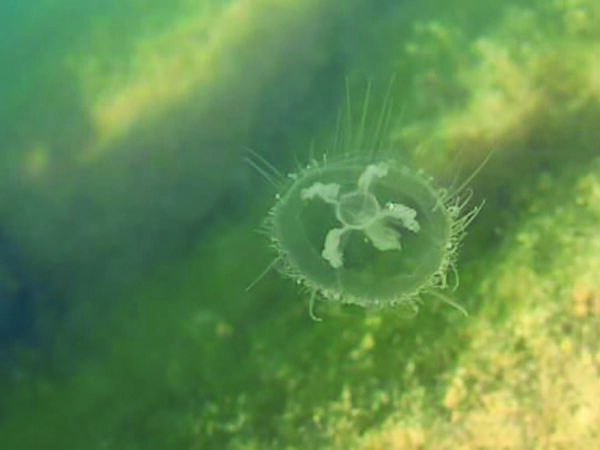PDF coming soon

Freshwater Jellyfish
(Craspedacusta sowerbii)
Species at a Glance
While similar in appearance to marine jellyfish, the Freshwater Jellyfish is considered a member of the hydra family and is not a true jellyfish. It is widespread around the world and has been in the United States since the early 1900’s. This jellyfish uses stinging cells to capture prey; however, these stingers are too small to penetrate human skin and are not considered a threat to people.
Species Description
The Freshwater Jellyfish exists in two main forms throughout its life. In the juvenile phase (the polymp phase), it is a small, 1 mm long gelatinous polyp that lacks tentacles. In this phase, it attaches to hard surfaces and forms colonies. The Freshwater Jellyfish is most easily identified in its adult phase (the medusa phase) as it has many of the characteristics of a true jellyfish such as a small, bell-shaped transparent body that is 5-25 mm in diameter. A whorl of string-like tentacles surrounds the circular edge of the body in sets of three to seven. The tentacles contain hundreds of specialized stinging cells that aid in capturing prey and protecting against predators.
Native & Introduced Ranges
Originally from the Yangtze River valley in China, the Freshwater Jellyfish can now be found on all continents worldwide. It was first reported in the United States in the early 1900s, presumably introduced with shipments of stocked fish and aquatic ornamental plants. Sightings are mostly concentrated in the eastern United States, but nearly all states have reported Freshwater Jellyfish sightings, with the exception of Montana, North Dakota, South Dakota, and Wyoming. In Pennsylvania, the first recorded report was in 1957 in Columbia County in a quarry near Bloomsburg Pennsylvania. This species is now widespread throughout the Commonwealth.
Biology & Spread
The most dominant form of the Freshwater Jellyfish’s life cycle is the polyp form which is tiny, attached to a surface, and can persist throughout the year. Other stages, such as the adult medusa and the resting body occur in response to specific environmental conditions. In favorable conditions, the polyp will form the medusa. In unfavorable conditions, such as low water temperature or prolonged starvation, the polyp contracts into a solid mass called a resting body that redevelops into the polyp when more favorable conditions resume. The polyps, like tiny seeds, may also be easily transported from place to place, with water, within shipments of stocked fish and plants, and they may even be able to spread on the feet of migrating birds.
Habitat
While it prefers small, calm bodies of water such as open lakes, ponds, reservoirs, waterfilled gravel pits, man-made impoundments, and recreational boating and fishing areas, the Freshwater Jellyfish has also been found in larger river systems. The familiar medusa form is mostly seen during the summer and fall months when warm water temperatures create an abundance of food.
Impacts
Threat to Biodiversity
The impact of the Freshwater Jellyfish is unclear, and more research is needed. There is currently no evidence to suggest that it is negatively impacting Pennsylvania’s ecosystems.
Health Risks
While the Freshwater Jellyfish has stinging cells, unlike marine jellyfish, they are unable to penetrate human skin and are therefore unable to produce the painful sting caused by most marine jellyfish.
Prevention & Control
Preventing the introduction and spread of the Freshwater Jellyfish is the best way to protect natural habitats from potential harm.
- Know how to identify and report the Freshwater Jellyfish.
- Always check for and remove plants, mud, and debris from boats, trailers, clothing, and equipment before entering a water body and before leaving a water body.
- Drain all water from bait buckets, bilges, and live wells before transporting to new areas.
- Clean all gear and equipment with hot water (140°F or 40°C) or salt water, OR let boats and equipment dry thoroughly for at least five days before entering a new water body.
References:
- Acker, T.S. & Muscat, A. M. 1976. The Ecology of Craspedacusta sowerbi Lankester, A Freshwater Hydrozoan.
- The American Midland Naturalist. 95 (2): 323-336.
- Erwin. A. Craspedacusta sowerbyi. Animal Diversity Web. Accessed August 2017 at:
- McKercher, E., O’Connell, D., Fuller, P., Liebig, J., Larson, J., Makled, T.H., and Fusaro, A., 2017,
- Craspedacusta sowerbyi Lankester, 1880: U.S. Geological Survey, Nonindigenous Aquatic Species Database,
- Gainesville, FL, Revision Date: 5/28/2013
- The Nature Conservancy. Journey with Nature: Freshwater Jellyfish in Indiana. Accessed August 2017 at:
- Whipple, W. Freshwater Biology, 2nd Edition. New York: John Wiley & Sons, Inc. 1959.



